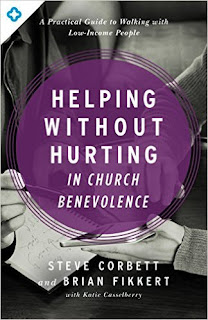AUTHOR: Steve Corbett and Brian Fikkert
PUBLISHER: Chicago, IL: Moody Publishers, 2015, (160 pages).
What do we do when a jobless man enters our church doors asking for help to pay his rent? How would our church respond when a woman walks into our offices asking if we could help her family pay her utility bills? While we would like to help, how do we differentiate the tricksters from the most needy? Do we have a set of guidelines on how to deal with such situations? Written primarily for churches in the United States and Canada, this book provides some simple principles and concepts to assist Church leaders in setting a benevolence policy. At the same time, the authors are aware that any help must not disempower the ones being helped. The authors are both professors at Covenant College who are keen on helping the needy without hurting them. As a follow up to their previous book, "When Helping Hurts," they seek to remind readers that poverty is a complex problem with no simple solutions. While reminding us not to disempower the needy by mere handouts or doing things for them, Corbett and Fikkert are eager to encourage churches to do more to help the poor and the marginalized. Central to their thought is this: How do we help the lost, the last, and the least without hurting their dignity?
The first two chapters cover the basic principles of poverty alleviation, and to show readers how complex the problem is in the first place. Being poor is not simply a lack of material things. In a materialistic world, people who define poverty on this basis will tend to presume that giving things is a solution to the problem of poverty. Not so simple. Poverty needs to be seen in the context of relationships. Our broken relationship with God; with one another; with creation; and with self. There are individual problems like addiction and relationship issues. There are people who abuse and exploit others. there are systems which are oppressive and enables the powerful to bully the weak. There are demonic forces at war and causing people to fight one another. Thus, poverty is complex because it is not simply a physical problem. It is also a spiritual one. That is why the authors define "poverty alleviation" as "a process in which people, both the materially poor and the materially non-poor, are empowered to move closer to living in right relationship with God, self, others, and the rest of creation." This process can be tackled in three ways: 1) Relief; 2) Rehabilitation; 3) Development. By learning to diagnose any one situation into the three categories, we would be better able to know when to issue handouts, and when not to. In Relief, we tend to do things FOR people. In Rehabilitation, we assist the weak and partner with them to do things for themselves. In Development, we empower them to help themselves. This idea is perhaps the most important idea that readers will get from the book. Straightaway, we learn not only to embark on new ways to help the poor, we also retain the old methods as part of our comprehensive arsenal of resources.
Chapters 3-5 cover tools and resources that can be used. They help us design and implement an effective benevolence ministry. This is crucial because it flashes out the nuts and bolts of the benevolence philosophy described earlier. We learn about how to focus on an appropriate benevolence philosophy; how to implement the policies; and how best to assign resources accordingly. Along with it are procedures and guidelines that churches can work through. The three key questions are:
- What is the problem to be solved? What do we understand by poverty?
- What is the goal of the benevolence policy?
- How do we achieve the goals set out?
For the uninitiated, one can work with the following as a starting point.
- "Because humans are relational beings, we will seek to provide material assistance in the context of long-term empowering relationships.
- Because Jesus Christ is the ultimate solution to poverty, we will seek to enfold people as full participants into His body, i.e., our church family.
- Because the goal is restoration to image bearing, we will use approaches that build on people’s own gifts, resources, and abilities."
Help the hurting. Be part of the solution. Volunteer to help in whatever way possible. Be a leader, a benevolent leader.
Rating: 4.5 stars of 5.
conrade
This book is provided to me courtesy of Moody Publishers and NetGalley in exchange for an honest review. All opinions offered above are mine unless otherwise stated or implied.

No comments:
Post a Comment